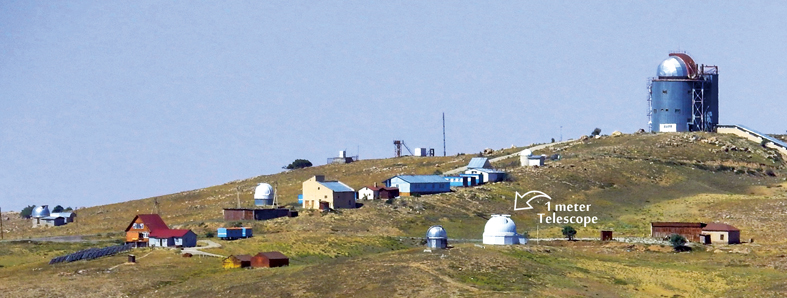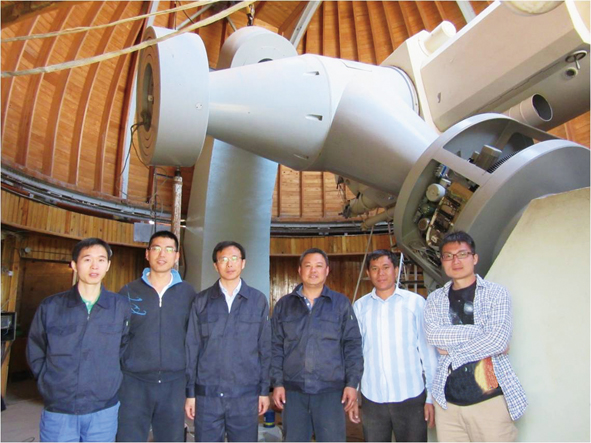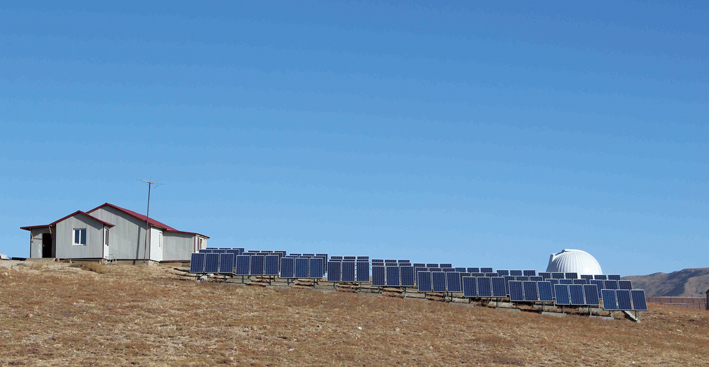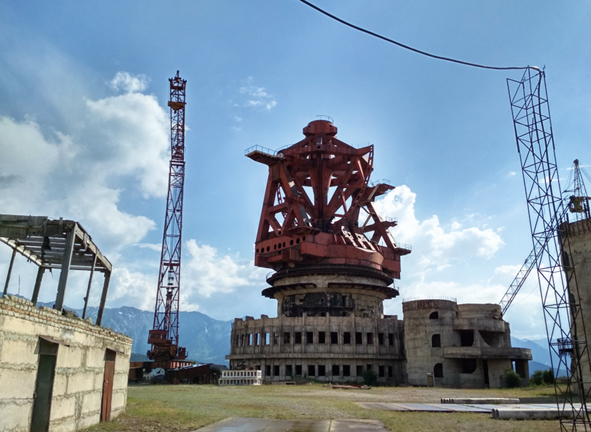— An Interview with Academician Shuhrat Ehgamberdiev, Director of the Ulugh Beg Astronomical Institute, Uzbekistan Academy of Sciences
Professor Shuhrat Ehgamberdiev is currently Director of the Ulugh Beg Astronomical Institute (UBAI) of the Uzbekistan Academy of Sciences. Thanks to his organizational and scientific skills, Maidanak Astronomical Observatory (MAO), which is a part of UBAI, has become one of the key observatories in a number of international projects requiring continuous monitoring of unique astrophysical objects.
In particular, he has been playing an active role in establishing close collaboration with the National Astronomical Observatories, Chinese Academy of Science (NAOC) since 2014, including the joint upgrade of Maidanak’s 1-m telescope and incorporating it into the network of telescopes for compiling a digital survey of the northern sky, which is expected to cover about 500 million celestial objects.
The scientific interests of Prof. Ehgamberdiev range from helioseismology, astronomical site selection, time domain astronomy to the history of astronomy. He is the author and co-author of more than 150 scientific articles. In 2014, he was assigned as a “Chevalier de l’ordre des Palmes Academique,” the highest award of France in the field of science. In 2015, he was awarded the ADIONS medal by the Cote d’Azur observatory of France. He was elected as an Academician of the Uzbekistan Academy of Sciences in 2017.
This summer, BCAS reporter XIN Ling had the privilege to interview Prof. Ehgamberdiev and share with our readers his insights into the glorious past of Uzbek astronomy as well as a bright future for the collaboration between Uzbekistan and China in optical and radio astronomy.

A general view of the Maidanak Astronomical Observatory with the 1-m telescope tower.
BCAS: First of all, would you tell us a few words about the history of astronomy in Uzbekistan?
Prof. Ehgamberdiev: The era of the most prominent achievements of science in the Middle East, North Africa, Central Asia and South Asia, known as the Islamic Golden Age, dates back from to the mid 8th to the 15th century. During this period of time, the Muslim world became a major intellectual center for science, philosophy, medicine, and education.
Since the 9th century, outstanding contributions to the world’s and Muslim astronomy have been made by our greatest countrymen Muhammad Khorezmi (Algoritmus) and Ahmad Farghani (Alfraganus), Abu Rayhan Beruni and Abu Ali Ibn Sina (Anicenna).
The development of Muslim astronomy reached its peak in the 15th century in Samarqand. Around 1428, Ulugh Beg and his colleagues completed the construction of a giant observatory, cylindrical in shape, 60 m in diameter and 35 m in height. In the middle of the observatory there were two meridian arcs, each with a radius of 40 m and its lower part entrenched 11 m into the rock. With this gigantic instrument they were able to determine with high accuracy a number of basic astronomical constants such as the duration of a tropical year, the inclination of the ecliptics towards the equator, the determination of time, and the annual motion of planets.

Chinese and Uzbek experts work together on the upgrade of the 1-m telescope.
As a result of over 30 years of intensive studies, a major work entitled Zij of Ulugh Beg (“Zij” means astronomical treatise) was compiled by Samarkand’s astronomers. The most important part of the Zij was a catalogue of 1,018 stars. It was the first observational catalogue to be compiled since the 2nd century when Ptolemy reproduced the Hipparchus catalogue in his Almagest.
Islamic astronomy, in particular the school of Ulugh Beg, had influences on the development of astronomy in China—for instance astrology and calendar making, which was of great importance to the authority of Chinese ruling emperors. There has been a lot of potential in China for research on the history of Islamic and Chinese astronomy, as well as their mutual influences, since enormous valuable information is contained in Chinese manuscripts and historical chronicles.
BCAS: When and how did Mt. Maidanak stand out as a unique astronomical site?
Prof. Ehgamberdiev: In the early 1960s, UBAI began to search for a new site for its future suburban observatory. After a decade-long site assessment campaign organized by UBAI, Mt. Maidanak located about 120 km south of the famous historical city of Samarkand, was selected. It lies on the spurs of the Pamir and Alai mountain system at 2,700 m above sea level.
Then in the early 1970s, the high-quality atmospheric conditions of Mt. Maidanak were confirmed. Though the summit was occupied by the Soviet Satellite Laser Ranging (SLR) station at that time, UBAI astronomers were allowed to continue astronomical observations with two 60-cm and one 48-cm telescopes in the neighborhood of the SLR station. Meanwhile, the Moscow State University and a few other Soviet Union institutions had erected their astronomical facilities at a neighboring summit situated 5 km to the west of Mt. Maidanak. So there were actually two “Maidanak” summits—the Eastern Maidanak hosting SLR station and UBAI Observatory, and the Western Maidanak hosting all other observatories.
Fast forward to the 1990s, and all observatories located on the west summit were accepted under the jurisdiction of the Republic of Uzbekistan. Today we understand MAO as the Western Observatory, with 10 telescopes and developed infrastructure. Most of MAO’s telescopes are involved in international observational projects with active participation of the former owners of the telescopes. These are world known astronomical centers in the Russia, Ukraine, US, Europe, Japan, South Korea, and NAOC of China.
Since the 1970s, estimations of meteorological data—the number of clear nights (about 2,000 hours per year) and a basic parameter of the atmosphere for an astronomical site, namely “seeing”—have been repeatedly conducted at Mt. Maidanak by several teams using different methods and instruments. And the expansion of international cooperation required extra data on Maidanak’s astroclimate, which was later obtained with internationally recognized methods. In 1996, MAO signed a contract with the European Southern Observatory (ESO) to use the ESO DIMM instrument for such “standard” measurement. The measurements and analysis of seeing at Mt. Maidanak with the ESO DIMM from August 1996 to July 1999 demonstrated that the median value of seeing there is 0.69, which indicated that the atmospheric conditions at Mt. Maidanak are comparable with those at the ESO observatories of La Silla and Paranal in Chile and at Roque de los Muchachos Observatory (ORM) at La Palma. Then other atmospheric parameters were also measured, in respect to adaptive optics and interferometry, such as the wavefront outer scale and the isoplanatic angle. The results confirmed the suitability of Mt. Maidanak’s atmospheric conditions for high resolution observations using adaptive optics.
BCAS: How did the collaboration between MAO and NAOC begin?
Prof. Ehgamberdiev: In 2013, the President of China XI Jinping made an official visit to Uzbekistan.
During his visit to the world famous historical Ulugh Beg Astronomical Observatory in Samarkand, together with then President of Uzbekistan I. Karimov, they decided to establish cooperation between astronomers of the two countries by taking advantage of the high quality atmospheric conditions of Mt. Maidanak and the high astronomical technologies of China. The subsequent instructions of both leaders led to the conclusion of a Memorandum of Understanding between NAOC and UBAI in 2014.
An interesting episode is that when President XI visited Samarkand and agreed with President Karimov to support the cooperation of Chinese and Uzbek astronomers on MAO, some people thought we were going to collaborate on the Samarkand Observatory. Even mainstream mass media of the two countries wrote about it incorrectly. Fortunately, the Ambassador of PRC in Uzbekistan Mr. ZHANG Xiao understood the instructions of President XI correctly and unmistakably conveyed it to the Government of China and to CAS.
An agreement signed between UBAI and NAOC in 2014 appeared to be a very important step for the further development of MAO. Within the framework of this agreement, Maidanak’s 1-m Zeiss telescope got upgraded. Uzbekistan has no experience in telescope making, so the most important technological part of work was done by engineers from XingLong and Xinjiang astronomical observatories as well as the Nanjing Institute of Astronomical Optics and Technology. We were very happy to work with our Chinese colleagues and we appreciate the generous support from CAS.

Astronomers from NAOC and UBAI celebrate commissioning after the acceptance of works on the upgrading of the 1-m telescope.
BCAS: Why was the cooperation important for both sides?
Prof. Ehgamberdiev: Frankly speaking, we were a bit late with the conclusion of the agreement with NAOC. But, as the Uzbeks say, better late than never. And we must strive to catch up. The fact is that astronomy in China is developing very rapidly. The agreement with NAOC is just the beginning, and I think many universities in China are interested in working with UBAI.
The basis for our cooperation is the scientific fact that most astrophysical objects undergo rapid variations in luminosity. Sometimes these changes occur with characteristic times of several hours or even minutes. For example, if such an eruption occurs when the night is at Maidanak, then in China is already dawning, and vice versa. Therefore, joint monitoring of such objects is much more effective than observation from one observatory since to detect variation is important to get crucial information about nature of such objects. Let me give one example. In May of last year, a supernova star explosion in Beidou constellation detected on Maidanak. Astronomers from Tsinghua University immediately took its spectrum at the Xinglong Observatory. Then we continued to observe it from Maidanak and got a very dense observing run. In summer, we have 90% of the maximum possible clear time! Now we have prepared a joint paper in a prestigious, high ranking scientific journal. Cooperation between UBAI and Tsinghua University on studying such objects is on the “conveyor” now.
BCAS: What will be the 1-m telescope’s scientific missions after upgrading?
Prof. Ehgamberdiev: The telescope’s main scientific task from 2018 will be a deep survey of the northern sky in cooperation with the Steward Bok 90-inch (2.3-m) telescope and Nanshan 1-m telescope of the Xinjiang Astronomical Observatory. I should mention that although there are several successful surveys of the Milky Way, for instance the Sloan Digital Sky Survey, surveys specially designed for obtaining stellar parameters are rare. The Stellar Abundance and Galaxy Evolution survey, with Professor ZHAO Gang from NAOC as its principal investigator, adopts a new photometric system, which is extremely powerful and sensitive to the atmospheric parameters (including effective temperature, gravity and metallicity) of FGK types of stars. With a limiting magnitude of 15 mag in V-band (S/N=100), the survey will take three to five years and will detect about half a billion stars.
It is expected that the SAGE catalogue with participation of MAO will become an important contribution to the development of astronomy, continuing the great traditions of Chinese and Uzbek astronomy.
BCAS: What is your vision for MAO in the future?
Prof. Ehgamberdiev: Organization for Islamic Cooperation during its First Summit on Science and Technology held in Astana, Kazakhstan in September 2017 proposed to install a 4-m telescope in Uzbekistan in honor of the great Uzbek astronomer Ulugh Beg. In the high quality atmospheric conditions of Mt. Maidanak equipped with an adaptive mirror, such telescope can provide the same or better resolution as the Hubble space telescope. The President of Uzbekistan Shavkat Mirziyoyev strongly supported this initiative, and at present the preparation for installing such a modern telescope on Mt.
Maidanak between 2019 and 2025 has begun. A 4-m telescope in Uzbekistan will significantly expand the scientific opportunities at UBAI and will open up entirely new ones, including spectroscopic capabilities in particular, with collaborative observation with NAOC’s LAMOST telescope, which today is one of the most advanced telescopes in the world for performing spectroscopic sky surveys.
We hope that Chinese astronomers will be interested in joining this project in order to further develop the advantages of collaborative research of the unique astrophysical objects with Uzbek astronomers.

With joint efforts of NAOC and UBAI, a 20kW solar power station was launched at Maidanak Observatory for uninterrupted power supply of the 1-m telescope.
BCAS: Are there other opportunities for astronomers in the two countries to work together in the future?
Prof. Ehgamberdiev: I definitely hope so, especially in the field of radio astronomy.
In fact, in the mid 1980s, the Soviet Union began to implement an ambitious project to build a 70-m radio telescope (RT-70) for submillimeter band radio astronomy. It was to become the world's largest radio telescope operating in the lowest-known range of radio waves, and the Suffa plateau in Uzbekistan was chosen as the site to construct the telescope. The Suffa plateau has not only an excellent astroclimate but also an advantageous geographical position.
After the collapse of the Soviet Union in 1991, the construction of RT-70 was mothballed. Recently, Russia and Uzbekistan have begun negotiations on the completion of the RT-70 radio telescope. Of course, in the past 30 years RT-70 has lost its importance as the world's largest fully steerable submillimeter radio telescope, but it could still be an important node of the global radiointerferometric network. Moreover, it is expected that the RT-70 will work in tandem with the Russian space radio telescope “Millimetron.”

The 70-m radio telescope RT-70 at Plateau Suffa, Uzbekistan under construction. (Courtesy of Photos: Prof. Shuhrat Ehgamberdiev)
Right now, there is not a single radio telescope within a large geographic area adjacent to Central Asia. The nearest 25-m radio telescope is in Nanshan, Xinjiang. The commissioning of RT-70 will be of interest for Chinese radio astronomers as well. We know that Xinjiang Astronomical Observatory is going to build in Qitai County by 2023 the world's largest fully steerable single-dish radio telescope (QTT) with an aperture of 110 meters. RT-70 can operate in a pair with QTT, which will greatly enhance the efficiency of both telescopes by synchronized observations of unique astrophysical objects. Secondly, the possibility of installing in Uzbekistan a radio telescope for the VLBI network is also being studied by Chinese astronomers. It will increase the efficiency of the network to solve a number of problems of geodynamics such as the definition of Earth rotation parameters, the creation of high-precision local geodetic networks, etc.

